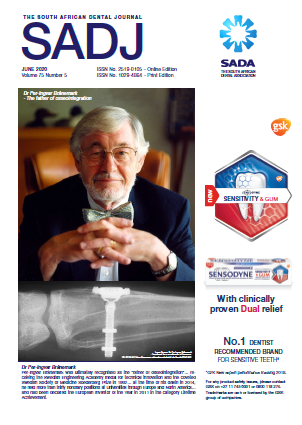Fraudulent records – Grave forensic consequences
DOI:
https://doi.org/10.17159/2519-0105/2020/v75no5a8Keywords:
forensic odontologist, victim identification, dental forensics, dental fraudAbstract
Natural disasters, fatal accidents, and violent criminal offences are part of everyday life. All of these may result in fatalities that shatter the lives of the victim’s families and friends. Their trauma is compounded by the fact that all unnatural deaths have to be investigated, and the bodies of the deceased positively identified before they can be released to the families for burial. Bodies of victims of violent crimes, fires, drowning, motor vehicle or aviation accidents, work place fatalities or situations where some time has elapsed since death may be so disfigured that “identification by a family member is neither possible or desirable”. Often the nature or degree of the injury may be so extensive that fingerprinting is also not a viable option. DNA analysis may be considered, however it takes time and is a costly procedure. There are also concerns with maintaining strict control over the chain of evidence during all additional procedures and tests. Thus, in these situations the forensic odontologist may be called in as part of the investigative team.
Downloads
References
Pretty IA., Sweet D. A look at forensic dentistry – Part I: The role of teeth in the determination of human identity. Br Dent J. 2001; 190(7): 359-66.
Gosavi S, Gosavi S. Forensic odontology: A prosthodontic view. J Forensic Dent Sci. 2012; 4(1): 38-41.
Singal K. Dentistry as a tool for identification. J Forensic Science and Criminology. 2015; 2(5): 1043.
Acharya AB. Are a minimum number of concordant matches needed to establish identity in forensic odontology? J of Forensic odonto-stomatology. 2003; 21(1): 6-13
Putter S, Naidoo S. Dental fraud in South Africa 2007-2015. SADJ. 2018; 73(9): 546-53.
Postma TC, van Wyk PJ, Heymans JH, White JG, Prinsloo PM. An analysis of complaints against oral health professionals charged with misconduct at the HPCSA: 2004-2009. SADJ. 2011; 66(9):420-5.
Nortjé N, Hoffmann, WA. Professional consequence for dentists involved in unethical decision-making in South Africa. J Forensic Odontostomatol. 2014; 32; 22-9.
Bernitz H. Forensic dentistry case book 4: Non-maleficence in dental practice, “primum non nocere”. SADJ. 2015; 70(7): 312.
The Concise Oxford Dictionary. 10th ed. Oxford. Oxford University Press. 1999; 562.
Downloads
Published
Issue
Section
License
Copyright (c) 2020 Leanne M Sykes, Liam Robertson, Herman Bernitz

This work is licensed under a Creative Commons Attribution-NonCommercial 4.0 International License.






.png)